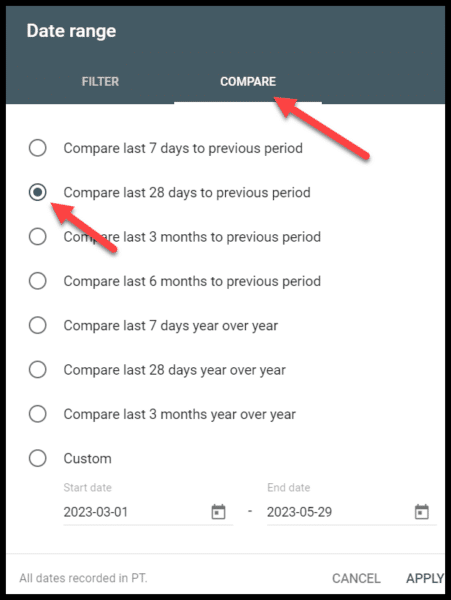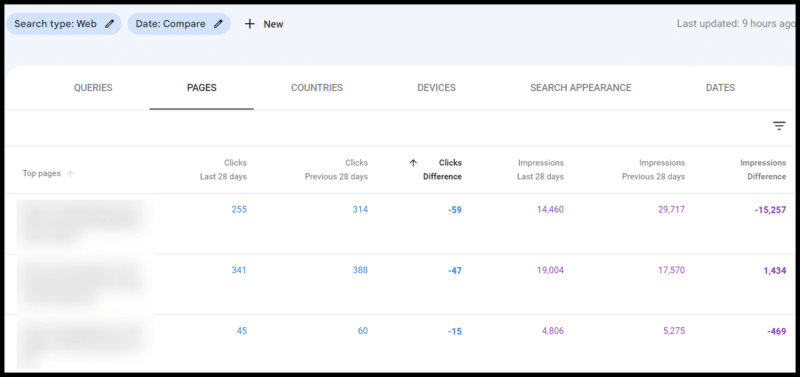Get your B2B site unstuck: Top SEO tips for stagnant sites

If you’ve ever analyzed traffic patterns for a website, you know that organic traffic ebbs and flows over time. Even the most authoritative sites will have older pages that see traffic drops.
With the recent run of algorithm updates, you might have a previously stable site that’s seen more turbulence (and even a longer-term flattening or drop) than it had in years past.
In this article, we’ll walk through steps you can take to reverse organic traffic drops or get your B2B site growing again if traffic has flattened.
Diagnosing organic traffic drops
First, it’s important to understand why you’re losing traffic. This is a good article that goes into greater depth on how to determine the real reason for a traffic drop (or flattening) which may be:
- A loss in rank due to algorithm updates.
- A drop in impressions due to a change in what’s displayed in search results (such as ads and search features like featured snippets, people also ask, etc.).
- A drop in click-through rate due to a mix of the above reasons.
Additionally, you’ll want to dig deeper to see which specific pages are at issue. Identify the time frame you’re looking at:
- If you’re seeing a steady decline, note the previous high and where the decline has been.
- If traffic is flat, note the period where it plateaued.
From there, you can start to look at date-range comparisons such as:
- The period where traffic dropped versus the previous period.
- The low versus the previous high if there was a drop.
- If traffic is flat: the most recent block of 28 days versus the 28 days where traffic was still growing.
As you dive into these comparisons, just be conscious of any seasonality and day-of-week differences that may mean your comparisons would be apples to oranges.
Once you know which date ranges you want to compare, you can start to see the pages that have lost the most traffic. You can do this in Google Search Console by clicking on date:
Then selecting compare and the date range you want to compare:

Once you do this, you can then click pages and sort the data by click difference to see pages that have lost traffic (even if traffic has been flat, you’ll likely have pages that have lost traffic – on an older site with a lot of traffic that is publishing new content, this is likely where your “traffic leak” is coming from):

Getting to the why: What’s changed?
Once you determine the pages that are losing traffic and that they are, in fact, losing rank (and aren’t just a victim of SERP changes), there are a number of steps you can take for each page that’s seen a drop to help regain traffic.
The first step is understanding why. To do this:
- Identify the terms that have lost traffic on a page.
- Go look at that SERP.
From your list of pages with the biggest page drop in GSC, you can then click the page (which creates a filter for that URL) and look at the queries, sorting by click difference in the same way you did for top pages:

You can then go look at the search results for those queries where you lost traffic. A few things may be true:
- More authoritative sites may be ranking.
- Google’s perceived search intent for that result may have changed (e.g., you may have had a large guide to restaurant marketing that ranked for the query, but now many of the results are “restaurant marketing ideas” list-style responses), and your page is no longer a good match for that intent.
- More specific content may now be ranking for a query where your broader page used to rank (e.g., your restaurant marketing guide used to rank well for Google Ads campaigns for restaurants, but now the SERP is full of guides that cover that topic exclusively).
- You may have the intent matched perfectly, but there may now be a flood of competitors creating pages on the same topic, and your content (which might have been the only show in town a year or two ago) may no longer be up to snuff
This is a good jumping-off point as it gives you direction on what to prioritize as you’re updating content that’s lost traffic. A good process to work through here is to:
- Export the pages that have lost the most traffic (ideally looking at a few different angles in terms of date ranges).
- Note the traffic drop as well as the queries that lost traffic and what you found when you inspected the SERP (why did your pages see a drop)
Now you can prioritize these based on pages that saw the biggest drops.
Importantly, if you are seeing drops on a certain content type, you want to do this inspection and update pages that are driving a lot of traffic even if they haven’t been hit yet.
If they are of similar age and content type particularly, it’s likely only a matter of time.
Ideally, you’ll have a process for prioritization and repeatable cadence for updating older content.
B2B assets that see drops
Diagnosing traffic drops isn’t a function that’s specific to B2B sites, but some B2B asset types tend to be particularly vulnerable to traffic drops, specifically:
Technical and trade-specific terms
Frequently, these are pages on your site that haven’t been updated in a long time and/or may be terms that you were early creating content around, but where other sites have created fresher, more thorough assets.
Recurring reports
If you put out an industry survey or “State of X” style report, those are often assets that can take a hit with time.
They often rank for a category or a basket of terms when the asset is initially created.
Then over time, other sites create more specific content that speaks to granular terms, and/or the search intent for the category term is something that shifts (i.e., a what is X page displaces a state of X report page).
Software or tool terms
Again, here assets like buying guides may be displaced with best-of lists (due to searcher intent).
Get the daily newsletter search marketers rely on.
https://www.leadbuildermarketing.com/seo-stagnant-b2b-sites-427783/
Comments
Post a Comment